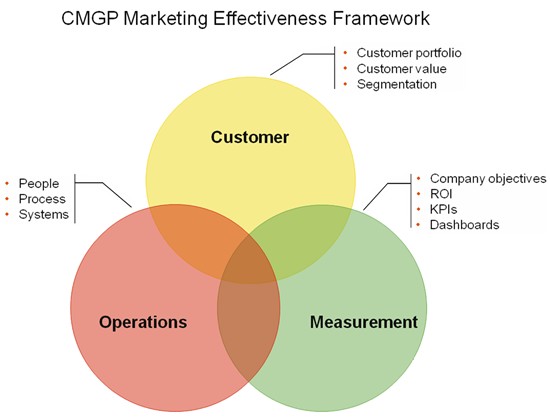Ever wonder why marketing departments are the first to have their budget cut? The answer lies in the poor job that most marketing leaders—and their departments—do in to tying their efforts to the bottom line.
In recent years, increased pressure on marketing accountability has spawned a growth industry of firms, system providers, conferences, and books on the topic of marketing effectiveness. All of these resources aim to improve the marketing efforts of businesses, which is an essential step toward maintaining positive growth.
However, the scramble to justify budgets can also result in a hyper focus on short-term metrics associated with ROI rather than a long-term sustainable path to continuous improvement.
Such short-term focus on ROI is not inherently bad and in fact often leads to substantial improvements to the marketing effort by recognizing quick fixes to existing tactics and beneficial shifts in marketing mix.
But marketing leaders should be asking not just how to measure effectiveness today but also how to improve marketing efforts week over week, month over month, and year over year. By committing to continual improvement and using a holistic approach, marketing can move from a defensive posture to a leadership position within the organization.
The path to continually improving marketing effectiveness involves understanding and addressing three key interrelated foundational areas: selecting the right metrics, optimizing marketing operations, and maximizing customer value.

Measurement: Selecting the Right Metrics
Selecting the right metrics and key performance indicators (KPIs) is not an easy task, and there are no simple recipes or formulas.
As members of the executive team, lead marketers today often become enamored with the abundance of metrics but fall short in stepping back to understand whether those metrics are helping them meet larger business objectives.
The key to picking the right KPIs is working backward from the end goal to find out how marketing can drive the desired result. If the end goal is increasing profitability rather than increasing market share, or improving brand health, the KPIs will be different.
In addition, KPIs should look beyond immediate tactical initiatives to understand whether the overall marketing operation is efficient and, even more fundamentally, whether you are attracting the right customers.
When stepping back, ask the following key questions (among others) to start with:
- What are your organization's objectives? What is your conceptual framework for how all your marketing efforts support those objectives?
- Are you measuring financial returns on all marketing campaigns?
- What are your key brand equity or health measures?
- What measures do you use to benchmark against the competition?
- How do you adjust for differences in channels, regions/countries, and segments?
- Do you have a testing/experimentation strategy before making large investments?
By addressing those questions, marketers can begin to understand what exactly it is they need to measure if they are to gain essential insights into their marketing activities.
Operations: Optimizing Marketing Operations
Improving marketing effectiveness goes beyond measuring the ROI of individual campaigns. To be successful at marketing effectiveness in the long term, your people, processes, and systems must support an effectiveness culture. Long-term improvement of marketing efforts requires both the culture and an infrastructure that encourage and allow for the continual analysis and interpretation of results.
For many companies just getting started with improving the effectiveness of their marketing, this operational shift requires significant change in the behavior and approach of management and leadership. Support should come not just from the CMO or lead marketer but also from other members of the executive team whose partnership is needed to put any major change in place.
Perhaps the most important partner in this effort is often the head of Sales, whose commitment to tracking and measurement of downstream results is crucial to getting a clear view of upstream marketing efforts.
Many organizations have a sales operations role whose sole function is to improve the operations of the sales department; this role is equally critical in the marketing organization.
Tools such as lean manufacturing principles and six sigma can be applied to help drive improvements in your marketing processes, while skills assessment and marketing training can help round out the marketing team's knowledge.
Finally, systems need to be put in place to help retire those Excel spreadsheets, store all necessary marketing data and customer information, track campaigns, and get the consolidated view of marketing practices necessary for better decision making.
Some questions to get you started:
- Do you measure your processes?
- Do you build a measurement component into planning new marketing efforts?
- Do your systems support the measurement of the metrics you seek to understand? What changes could be made to make this information more readily available?
- Does your team have the right skills to measure your processes and drive improvements?
- Is there an open line of communication between your frontline and executive-level teams?
If you are not tracking your data at the individual customer or segment level, you are behind the curve. Effective communications should seek to become as personalized to the unique needs of your customer or segment as possible.
Customer: Maximizing Customer Value
Maximizing customer value is achieved through linking customer value to company value. To maximize customer value, marketing organizations need to understand their customer portfolio, the value that customers assign to the company's products and services, and how the customers interact with the company throughout the customer lifecycle.
Effective marketing by definition focuses on the high-value customers—those that buy repeatedly, recommend to others, spread positive word-of-mouth, and are more likely to buy additional products and services from your company.
Segmentation strategy, loyalty metrics, and the voice of the customer are all tools that can help companies find, retain, and grow this customer group.
Some questions to ask:
- Have I segmented my customers and prospects to align messaging and maximize marketing efforts with differences in needs?
- Do I know who my most profitable customers are? What changes can be made to convert middle-of-the-road customers into loyal, profitable customers?
- What is the buying process for a new customer?
- How do we align ourselves to support our customers through their lifecycle?
The Intersection: The Sweet Spot
Implementing only one of the above approaches will lead to an imbalanced effort. The path to marketing effectiveness involves optimizing the intersection of your operations, measurements, and customers.
By knowing what to measure and who to target, and making sure that your operation can support your efforts, you can build a foundation that will allow you to improve the marketing strategy and programs (branding, campaigns, etc.) at your organization.
Ultimately, only through driving improvements in all three areas will you maximize the long-term value of your marketing efforts in quantifiable ways that can be communicated to all relevant stakeholders.




